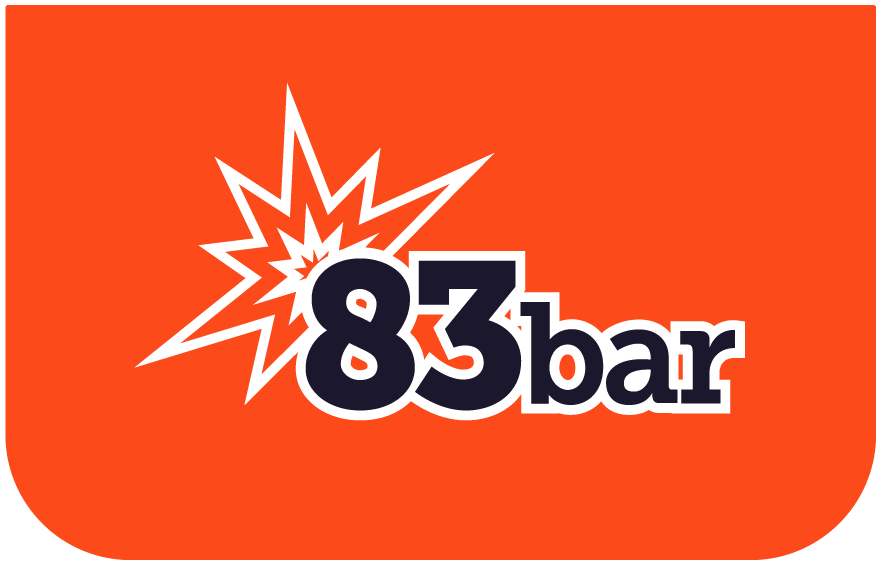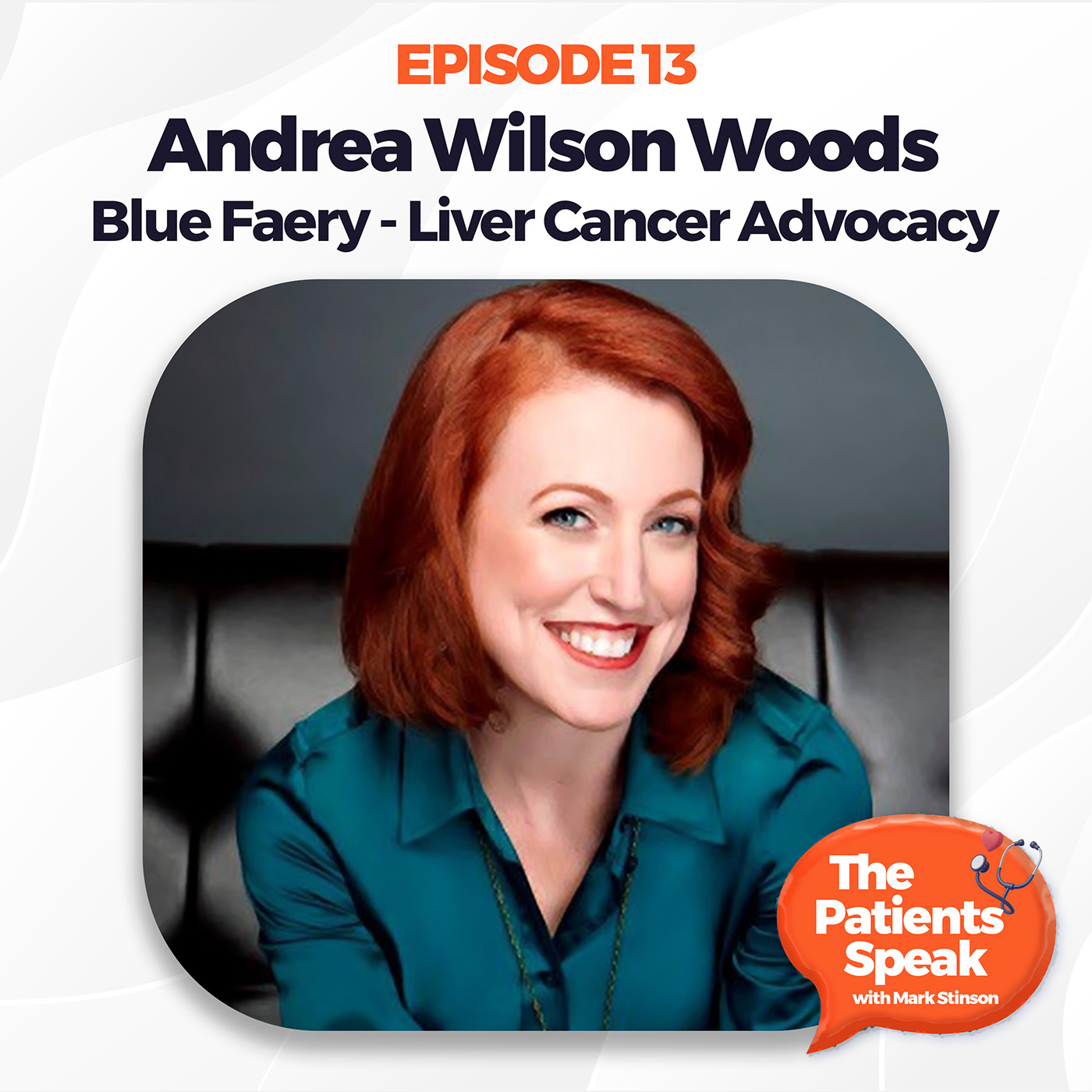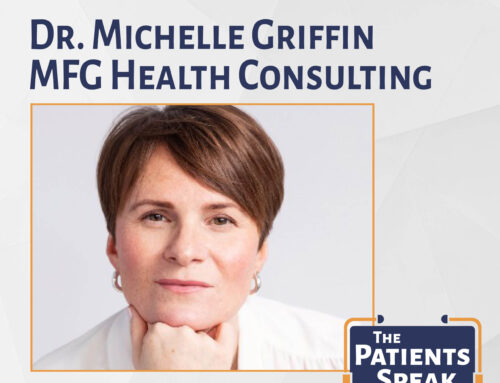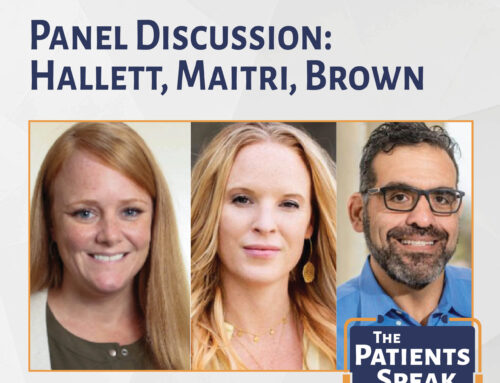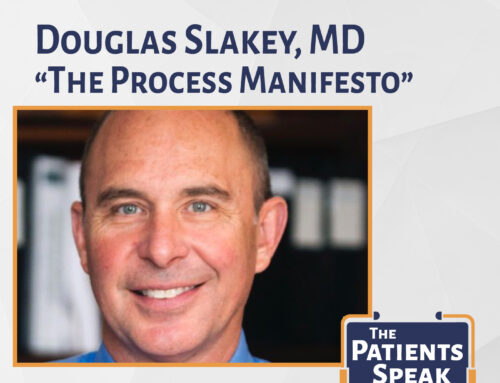Hello everyone and welcome back to our podcast, The Patients Speak, where we’re combining the business and science innovations of healthcare with the patient voice and how to help them navigate the system to get from diagnosis to wellness faster and more smoothly, and navigate the complicated healthcare system.
Today our guest is Andrea Wilson Woods, president and founder of a non-profit called Blue Faery for liver cancer. She is also the CEO of Cancer U, a for-profit social impact healthcare startup in addition to being the author of a best-selling book, Better Off Bald: The Life of 140 Days. It’s a medical memoir about raising her young sister.
Mark Stinson:
Hello and welcome again to our podcast, The Patients Speak, where we combine business and science, innovation of healthcare with the patient voice, what we need to hear when the patients speak, and how to integrate their experiences and their desires in getting from diagnosis to wellness all throughout that journey, and how to make that journey easier, faster, and more effective for patients. And I’m just so glad today to have a special guest, Andrea Wilson Woods. Andrea, welcome to the program.
Andrea Wilson Woods:
Oh, thank you so much for having me, Mark, and for doing this podcast.
Mark Stinson:
Well, I think it’s important too, and certainly with your background, we’re going to talk about a lot of different things from your patient advocacy experience. You’re the president and founder of a non-profit called Blue Faery for liver cancer. You’ve also founded, and you’re the CEO of Cancer U, a for-profit social impact healthcare startup. Now, just in that mouthful alone, you’ve got a lot to explore. And Andrea is also the author of a best selling book, Better Off Bald: The Life of 140 Days. So it’s a medical memoir about raising her young sister, and there’s a lot to learn from that experience too. But, Andrea, maybe if we could start off, I mean, we titled this whole podcast The Patients Speak, so we really want to have our ears wide open to the patient’s experience and what they want and what they’re trying to tell us in the healthcare community. From your work in all these non-profits and patient advocacy organizations, what do you think we need to hear the most from the patient?
Andrea Wilson Woods:
I think you just need to not assume that you know what a patient wants, you need to listen and really listen and ask more questions. I remember meeting this doctor one time at a medical conference, and he was from Egypt, and we were talking about advanced liver cancer and he told me that with his patients who had advanced liver cancer, that he didn’t tell them that they were going to die. He didn’t tell them it was a terminal diagnosis. He didn’t give them any options. He didn’t discuss palliative care and what that means, and instead he just treated them until they died.
So, I asked him, “Well, what would you do if you were diagnosed with metastatic hepatocellular carcinoma tomorrow? What would you do?” And he told me all these wonderful things. I would apologize to my father. I would take my wife on this trip. And I said, “Oh, so there are things that you would like to do before you die?” And he said, “Yes.” And I said, “Well, why don’t you give patients that option?” I said, “If you had real conversations, you would allow your patients to have choices, but instead you are treating them and not giving them a real picture.” And I can’t tell you how many times, Mark, a patient has believed that because the doctor is treating them, that the treatment has to be curative when it’s not. It’s often palliative.
Mark Stinson:
Interesting. And so, it sounds like when we talk about advocacy and advocacy groups, so often we are saying, hey, we’re promoting research, we’re promoting cures, but you’re also saying, we’re advocating for choice that the patient needs to be engaged and certainly own those choices.
Andrea Wilson Woods:
Absolutely. Absolutely.
Mark Stinson:
Well, tell us about some of what Blue Faery is doing in the area of liver cancer. And it’s also a very personal story about how you started this organization.
Andrea Wilson Woods:
Yes. So Blue Faery’s mission is to prevent, treat and cure primary liver cancer, specifically hepatocellular carcinoma through research, education, advocacy. And I started Blue Faery in memory of my sister Adrienne. I was 22 years old living in Los Angeles. When I got custody of Adrienne, she was eight at the time. So there was a significant age gap. We have the same mother, different fathers. Her father actually died before she was born, so she didn’t know him. I became her legal guardian, I was her parent, and I raised her all through my 20s until she was diagnosed with Stage 4 liver cancer about a month after her 15th birthday. And it was so sudden, it was the day before no symptoms, that day, she was in such horrible pain that we ended up going to her pediatrician who sent us to the ER, and it was actually an ER doctor.
I’ll just never forget the look on his face because he did not expect what he saw. But it was the ER doctor who said that she has tumors in her liver and lungs. And that night, they sent us to Children’s Hospital Los Angeles. A week later she was doing her first round of chemo, and she only lived 147 days with that diagnosis. And this is a very special time of year for me because she died on October 9th, 2001. So it’s actually been 21 years, but it had an enormous impact on my life. The year after Adrienne died, I turned 30 years old to give your listeners some perspective. So it changed the whole course of my life. And I started Blue Faery because, at that time, there was not a single organization in the US doing anything in liver cancer for patients and caregivers. And I didn’t want people to go through what we had gone through.
Mark Stinson:
And I’ve noted that we’re talking on the occasion of the 20th anniversary of the founding of the organization. How have you seen it change and evolve? And again, you’ve sort of moved now from a very personal family mission to a much larger mission.
Andrea Wilson Woods:
Yeah. It has grown so much, especially over the last seven years, this is sort of negative, I don’t know, but as more pharmaceutical companies have realized that more people are getting liver cancer and that they can actually make drugs to help people live longer, it’s led to our growth, it’s led to us being able to get more funding in a variety of ways, but it’s also led to us helping patients and seeing patients live longer with better quality of life. So, we have a research award, we give out every year on my sister’s birthday, and we’ve been able to increase that over the years. And we also have a lot of patient education programs. All of our patient education materials are free. We ship worldwide for free, and they’re in multiple languages. And then we have a lot of different advocacy programs.
And about a year ago, we started our first real aim at prevention because as you well know, but perhaps your audience doesn’t, liver cancer is one of the deadliest and yet one of the most preventable cancers. It’s highly complex because usually some sort of liver disease is involved, and that makes it very difficult to treat. And so, we started our first liver disease and liver cancer prevention and awareness campaign, and that has expanded. We call it Love Your Liver. And it’s been so exciting to see it grow. We also have a private online community, HIPAA-compliant i.e., not a Facebook group for patients and caregivers. And it’s just wonderful to see how the community has come together and support each other as well.
Mark Stinson:
Well, you mentioned our understanding and appreciation of what is possible and what the disease really is all about and how it can be prevented and how it can be intervened if it has progressed. I guess, I think about the companies that are sponsoring and supporting the organization, and certainly the companies have representatives called Patient Affairs and Patient Advocates and clinical liaisons and so forth. But have you had the opportunity to turn the tables and educate them to our point about patient voice, that this is what you really need to understand from us patients and us caregivers?
Andrea Wilson Woods:
Yes, I have. I’ve been very fortunate. There’s one small biotech company that actually bought my book for all of their staff because they wanted people to truly understand the patient experience. And as you mentioned in the opening, my book is a medical memoir, and it gets into the nitty gritty details. You’re really living the experience the way my sister and I did during that 147 days. And I’ve also done sort of in-house education days full on days, again, where I am training, I guess is the best word, but educating people who are either sales or even medical affairs and helping them better understand the patient journey.
And I think the one thing that I feel like, and this is just broad, that perhaps these companies don’t understand, is that most people are not seen in an NCI cancer center. Most people are not going to have that multidisciplinary team unless they move their care. Most people are seen in a community cancer center. They might have a community oncologists who is a general oncologist who does not specialize in liver cancer, and that will change their care. And it’s also why so many cancer patients and caregivers don’t know about clinical trials or certainly don’t know how to find one.
Mark Stinson:
Well, I think, let’s talk about that for a second. Certainly the presenter of this podcast, 83bar is involved in the recruitment of potential candidates for clinical trials. What is it about that gap that we need to close? I mean, part of it is a system gap, you just simply don’t have the cancer units in every hospital that we should. But it’s also an educational gap. What is available and how can I, as we’ve talked about, advocate for myself to get information about the trials that are available?
Andrea Wilson Woods:
Sorry, I am so hoarse. I don’t know why. So I’m trying to get past it. Well, I love to tell stories. So I’m going to tell a story to illustrate this point, and this is actually comes from Cancer U. So there’s this lovely couple named Sam and Diane and I will never forget their names because I loved to cheers in the 80s. And he has metastatic non-small cell lung cancer. She is his caregiver, and they were told to go home, get his affairs in order, all the treatment had been done. Now they had some inkling of clinical trials, but didn’t know what to do. They had joined Cancer U, they had found us on Facebook, and we didn’t have a lung cancer course yet so they reached out and said, “What can we do?” And I said, “Well, would you mind we can make you a case study. We’ll record it, other people can learn, and I will teach you one-on-one how to use ClinicalTrials.gov,” which is probably one of the least user friendly websites in the world.
Mark Stinson:
Exactly. It’s not the most patient friendly source.
Andrea Wilson Woods:
It is not. It’s not easy for anyone, right? And so, that’s what we did. So we spent an hour going through understanding how to use it. But what we also did, and this is where I feel like industry misses the mark, is I worked with them on what are their core values? What were their deal breakers? And they had a big deal breaker that was going to affect any clinical trial. They did not want to go anywhere that was more than 15 minutes from their house because they didn’t like to drive, especially at night. They were both over 60 and they just didn’t feel comfortable, and they didn’t have anyone else who could drive them. And so, luckily they do live in a suburb of Atlanta, so that helped, but it still limited things. So in one hour, we identified five possible clinical trials, and I reached out a week later to see what happened.
And Diane responded and said, “Oh, those five trials didn’t work out.” But, because she had learned how to use ClinicalTrials.gov, when those five trials didn’t work out, she got right back on the website, found a trial, and got Sam enrolled, and it was less than 15 minutes from their house. Now, why their oncologist did not suggest that to them? I don’t know. And I don’t believe in peddling and false hopes, so I also want to add that Sam was very clear, he felt good, he didn’t feel sick. And he said, “As long as I feel good, I want to keep going. If I feel bad, then of course not. But I still feel good, so I want more time with my wife.” And that’s a good reason to enter a clinical trial. That’s a good reason to keep going.
Mark Stinson:
Yes. Well, it’s interesting you say armed with the information and sort of the training and capability of using the tool, you have more choices.
Andrea Wilson Woods:
Yes.
Mark Stinson:
I mean, going back to advocating for choice, if you think you only have these three or four options, well then, you’re limited. But if you have even more options, it does. Did they feel empowered? We use this word a lot, empowered patients. Did they feel empowered with this knowledge and ability to use the tool?
Andrea Wilson Woods:
Yes, certainly she did. And that’s another thing I think that gets missed is how much caregivers do? How much they are leading the charge when it comes to care? How important that is that caregivers are part of every conversation? Because I didn’t realize this until someone said this to me, but typically that primary caregiver, whether it’s a spouse, an adult, child or sibling, or even a parent of a pediatric patient, that caregiver is the secretary, the butler, the chauffeur, the maid, the cook. That caregiver knows everything, so you need to get them in on the conversation from the get go.
Mark Stinson:
So helpful. Well, you touched on your other venture, and I wanted to move to that too, and that’s Cancer U. Tell us about how you’re educating and engaging that cancer patients through this really university type offering.
Andrea Wilson Woods:
Yeah. So, Cancer U is an online platform for both cancer patients and caregivers to educate, empower and engage them to become advocates for their care, to improve outcomes, to lower stress and reduce cost. So, we use courses for education, we use community for engagement, and we use coaching for empowerment. And it really is designed like this holistic university style model.
Mark Stinson:
And all online, and what’s the modality? Tell us about how the information is taught.
Andrea Wilson Woods:
Yeah. So I come from a teaching background. When I was raising my sister, I was a teacher, and then after she died, I went back to school. I like to say I gave USC more of my money and got my masters, and I was also an adjunct professor. So, that’s my wheelhouse, that’s where I’m super comfortable. So I feel it’s very important to address all learning styles, so there’s video, there’s audio, there are downloadable worksheets to address all those modalities. The coaching is done online, typically in a Zoom type situation. And then the community is strictly online, but people can engage with photos. We don’t have the video component yet of the community, but that is something we’re looking into.
Mark Stinson:
Well, and I guess our listeners may be surprised. So I wanted to really get under the hood of Cancer U. It reads like a healthcare startup, I guess because it is.
Andrea Wilson Woods:
Oh, yeah, it is.
Mark Stinson:
The language of getting funding joining tech support groups, so to speak, and really learning telemedicine and getting digital health portfolio support, even Microsoft support. So tell us about that side of it. The entrepreneurial, the business side of trying to build this kind of initiative.
Andrea Wilson Woods:
Cancer U really came out of me trying to solve a problem that I saw my own advocacy group and others. One of my frustrations with Blue Faery that I realized pretty early on was it wasn’t enough to give patients educational materials, even if they are free, and they are in layman’s terms and in multiple languages, what was happening is that patients and caregivers were reaching out to me and asking for more help. So they had the what, but they didn’t know the how, they didn’t know how to act on the materials they had been given, and they had more questions. And so, I had been coaching patients and caregivers pro bono for over a decade. And it started small, and it was only in liver cancer, and then it was just word of mouth until it got to the point it was unsustainable because I can’t scale myself. But I could not bring myself to charge patients and caregivers because I’ve been there and I just couldn’t do it.
I could have made a very lucrative business out of being a personalized cancer coach, and I don’t shame or blame anyone who does that, but it just wasn’t for me. So I just kept percolating over, how can I solve this problem? Meanwhile, people are sending me their medical records through Facebook Messenger, unsolicited, mind you, unsolicited. And I was like, this is crazy, but clearly there’s a need. So I kept thinking about it. I kept thinking about my own situation how. With my sister, I was asked to make these major decisions about her treatment less than 48 hours after being told about these tumors in her liver and lungs. And I was somewhat comfortable in that environment because our mother had been a nurse. So I grew up around doctors and hospitals, and still they were throwing all these acronyms at me. It was like the alphabet stoop of cancer, I call it.
And to me, it was like, you have to go back to school. You really have to go back to school. And I was like, “Oh my gosh, Cancer University.” So I had this crazy idea in the summer of 2017, and I entered this competition called the C 3 Prize. It’s sponsored by the pharmaceutical company as Stella’s, it’s their changing cancer care prize. And that year it was co-sponsored by Robert Herjavec from Shark Tank. His mother died from ovarian cancer, I believe. And so, he’s very passionate about this. So I thought, “I have this crazy idea. I’m going to enter this contest, we’ll see.” I really didn’t think much about it. I threw together a webpage. I thought, “We’ll see what happens.” Well, to my surprise, I ended up getting into the semifinals. They had over 160 entries from 21 countries, and I got in the top 10, and I spoke with the Stella’s executives.
They totally got where I was going with it. They loved it. And I didn’t get into the finals because I just had a webpage with a video, but it gave me some momentum. And I was very nervous about going into the health tech space and the for-profit. So I spent six months vetting the idea with patients, caregivers, advocates, survivors, all the doctors that I know, all the pharma contacts that I have, and every single person said yes. Every single person said, “Yes, you’ve got to do this. There’s a need for this.” And so I found a co-founder. I did not have a co-founder for Blue Faery, and so it was very important for me to have a co-founder with a completely different skill set. I didn’t want to do it alone. And so we co-founded the company officially in the spring of 2018. And we’ve bootstrapped the business, and it’s not been easy. I want to be very honest, it’s been incredibly tough. It really has. And I’ve put my life savings into the business.
Mark Stinson:
Yes. Well, and every entrepreneur, whether they’re in health or otherwise, any tech entrepreneur knows this term, bootstrapping. It sounds glamorous.
Andrea Wilson Woods:
Oh God, no. It should be going broke.
Mark Stinson:
Yeah. Exactly.
Andrea Wilson Woods:
I just heard another entrepreneur say that she’s still recovering from a poor credit score because one time, for a three month period, she didn’t pay her credit card. And that was four years ago. And she still, her credit score hasn’t recovered from four years ago.
Mark Stinson:
When you’re literally putting everything in. Well, my guest is Andrea Wilson Woods. Andrea, before I have a couple of questions about how we go forward here, but I want to make sure we pause here to help you give us the coordinates where we can find you, where we can learn more about all these great programs.
Andrea Wilson Woods:
Of course. So for Cancer U, just go to cancer.university. For Blue Faery, it’s bluefaery.org, F-A-E-R-Y.org. For me personally, it’s just my name, andreawilsonwoods.com. And to get the book, go to betteroffbald.com.
Mark Stinson:
Well, lots of good resources there. Lots of good experience. Andrea, as we think about the two, I’ll call them audiences, but two groups we’ve been talking to today, the other advocates, I want to ask you, what insights and advice would you give somebody who’s trying to build an advocacy group, an organization, a healthcare startup, perhaps? Based on your lessons learned, what insights would you give them?
Andrea Wilson Woods:
If you’re doing a healthcare startup that has a tech component, and I’m thinking of another entrepreneur I know who shares this, we commiserated with each other in June, make sure one of your co-founders is a tech co-founder. It’s really important. I feel like it can make or break you. If I could go back and change anything, that would be it. I would’ve brought in a tech co-founder because it gets very, very difficult when you’re trying to build a product that’s enabled by tech.
For advocates, gosh, I don’t want to give discouraging advice, but I want to give realistic advice. I feel like the charity space is anything but charitable. It is more cutthroat than the for-profit world. It is highly competitive. And unfortunately, the way charities are set up, we end up competing with each other for a very limited pot of money. And you just have to stay true to your mission, you don’t get distracted by your quote “competitors”. And there will be competitors. It’s not always easy. We do our best at Blue Faery to collaborate with others who share our mission. We work well with the Cholangiocarcinoma Foundation, so they focus on liver cancer, but a different kind of liver cancer. And we work with other organizations that focus on different liver diseases, but it’s just not always easy. It’s surprising how flat out mean, some people are.
Mark Stinson:
Well, it sounds like to find your space and maybe seek those collaborations, but be aware that there may be this competitive set.
Andrea Wilson Woods:
Be aware. And I know one woman who is a strategic planner and works with lots of non-profits, and she always advises that don’t start a non-profit in a particular space if someone else is already doing it in that space and doing it well. And I think that’s a great piece of advice. I never would’ve started Blue Faery if there had been a HCC advocacy group, but there wasn’t, and that’s why I started Blue Faery.
Mark Stinson:
Well, and then turning to the other group, the clinical people, the marketing people at the pharma, biotechs, med devices, diagnostics, what advice would you give that part of the industry to do a better job of listening? We’ve been really focused on how to hear what the patient’s talking about. How can we do that better?
Andrea Wilson Woods:
Leave all of your preconceptions or thoughts. Leave them at the door because I promise you, they’re wrong. I promise you, they’re wrong. For example, I’m thinking of a couple right now that live in a very rural part of Texas. So rude that it’s very difficult to find their trailer out in this highway in the middle of nowhere, and this woman emailed me thanking me that my book was on Kindle Unlimited now, because she could get it, because they could not spare $15 for paperback book.
That is something I think most people do not comprehend at all. And of course, I immediately just mailed her a paperback book, but she also didn’t think to ask. And so, I think now we are talking a lot about underserved populations in the purview of race and ethnicity, but we’re not talking about underserved populations in terms of socioeconomic, and there’s definitely overlap. But to me, that’s where I see the biggest need is everyone in this country who is living at or below the poverty line. And as someone, I was there, I’ve been there, and it’s really difficult.
Mark Stinson:
Well, and it really seems to ripple into this concept of access. We talk about access to healthcare, but you’re even saying access to the resources, access to the information. And I have been in meetings where people will say things like, “Well, it’s on the internet. Everybody can find it. It’s in books and everybody can find it. It’s at the hospital, there’s pamphlets and they can pick them up.” But this idea of access does lead us to a broader definition, doesn’t it?
Andrea Wilson Woods:
Yeah. Can I share one last story-
Mark Stinson:
Please do.
Andrea Wilson Woods:
… just going to make you laugh so hard? So we were pitching to this one investor about a year ago for Cancer U, and this is the only person we ever had to do this with, we had to sign NDA just to speak with him. It was very odd. But he is connected to the most prominent political family in New York. Whoever just popped into your head is probably that person. And so, he’s very well known and so we’re pitching Cancer U, and I kid you not, this was his response. “Well, I don’t get it. Why wouldn’t you just get in your plane and fly to Mayo. Get in your plane.” And he’s talking about a private plane, people, and fly to Mayo.
Mark Stinson:
Not a plane, your plane.
Andrea Wilson Woods:
Your plane and fly to Mayo. And I almost lost my mind. I was so mad. I was so hop and mad. I really was. But talk about living in a bubble.
Mark Stinson:
We got a lot to learn. I love that. Well, Andrea, thanks for that story and thanks for the other insights and experiences you’ve shared with us. I mean, again, very personal and very real. I mean, there’s a real people that are facing real health challenges, and we can do a better job of listening, can’t we?
Andrea Wilson Woods:
Yeah, absolutely. Thank you so much.
Mark Stinson:
It’s a good call to action. Well, thank you and good luck in both of these initiatives. And listeners, come back again next time. We’re going to continue these conversations. We’ve been talking to healthcare executives, we’ve been talking to medical providers and researchers, and we’ve been talking to patient advocates like Andrea Wilson Woods today about what we can learn when we really bring in the patient voice. So we’ll continue to listen to The Patients Speak. I’m Mark Stinson. Bye for now.
